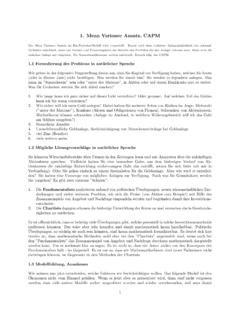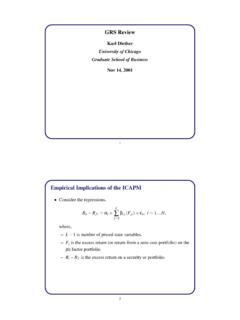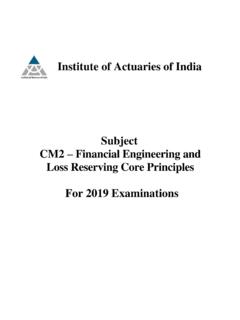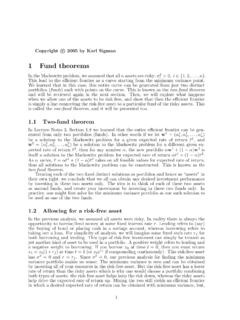Transcription of 1 Portfolio mean and variance - Columbia University
1 Copyright c 2005 by Karl Sigman 1 portfolio mean and variance Here we study the performance of a one-period investment X0 > 0 (dollars) shared among several different assets. Our criterion for measuring performance will be the mean and variance of its rate of return; the variance being viewed as measuring the risk involved. Among other things we will see that the variance of an investment can be reduced simply by diversifying, that is, by sharing the X0 among more than one asset, and this is so even if the assets are uncorrelated. At one extreme, we shall find that it is even possible, under strong enough correlation between assets, to reduce the variance to 0, thus obtaining a risk-free investment from risky assets.
2 We will also study the Markowitz optimization problem and its solution, a problem of minimizing the variance of a Portfolio for a given fixed desired expected rate of return. Basic model You plan to invest a (deterministic) total of X0 > 0 at time t = 0 in a Portfolio of n 2 distinct assets, and the payoff X1 comes one period of time later (at time t = 1 for simplicity). Apriori you do not know how to distribute the amount X0 among the n assets, your objective being to distribute X0 in such a way as to give you the best performance. If X0i is the amount to be invested in asset i, i {1, 2, .. , n}, then X0 = X01 + X02 + + X0n . The Portfolio chosen is described by the vector (X01 , X02.)
3 , X0n ) and its payoff is given by X1 = X11 +X12 + +X1n , where X1i is the (random) payoff from investing X0i in asset i, that is, the cash flow you receive at time t = 1. Ri , called the total return, is the payoff per dollar invested in asset i1 , X1i Ri = . X0i We define the rate of return as the corresponding rate def X1i X0i ri = R i 1 = ;. X0i and it holds then that X1i = (1 + ri )X0i . But note that unlike fixed-income securities, here the rate ri is a random variable since X0i is assumed so. The expected rate of return (also called the mean or average rate of return) is given by ri = E(ri ), and since X0i is assumed deterministic (non-random) it also holds that E(X1i ) = (1 + ri )X0i.
4 Shorting is allowed, so some of the X0i can be negative (as well as positive or zero), as long as X01 + X02 + + X0n = X0 > 0. It is convenient to define weights (also called proportions), X0i i = = proportion of resources invested in asset i, X0. 1. The point here is that the assets are bought/sold in shares and any proportion thereof. So if one dollar buys shares of an asset, and yields payoff 6 dollars, then 10 dollars buys 4 shares and yields payoff 60 dollars. 1. and it follows that n X. i = 1, i=1. and the Portfolio can equivalently be described by ( 1 , 2 , .. , n ) with rate of return, and expected rate of return given by n X.
5 R = i ri (1). i=1. Xn r = E(r) = i ri . (2). i=1. Letting i2 = V ar(ri ) = E(ri2 ) r2i , and ij = Cov(ri , rj ) = E(ri rj ) ri rj , the variance of rate of return of the Portfolio is given by n X X. 2 = V ar(r) = i2 i2 + 2 i j ij . (3). i=1 1 i<j n 2 is a measure of the risk involved for this Portfolio ; it is a measure of how far from the mean r our true rate of return r could be. After all, r is an average, and the rate of return r is a random variable that may (with positive probability) take on values considerably smaller than r. Note that the value of X0 is not needed in determining performance, only the proportions ( 1 , 2.)
6 , n ) are needed: Wether you invest a total of one dollar, or a million dollars, the values of r, r and 2 are the same when the proportions arePthe same. In effect, any Portfolio can simply be described by a vector ( 1 , 2 , .. , n ), where ni=1 i = 1. Clearly we could obtain 2 = min{ 12 , 22 , .. , n2 } by investing all of X0 in the asset with the smallest variance ; thus it is of interest to explore how, by investing in more than one asset, we can reduce the variance even further. We do so in the next sections. Reducing risk by diversification One of the main advantages of investing in more than one asset is the possible reduction of risk.
7 Intuitively, by sharing your resources among several different assets, even if one of them has a disasterous (very low) payoff due to its variability, chances are the others will not. To illustrate this phenomina, let us consider n uncorrelated assets ( , Cov(ri , rj ) = 0 for i 6= j) each having the same expected value and variance for rate of return; ri = , i2 = 1. If you invest all your resources in just one of them, then the performance of your investment is (r, 2 ) = ( , 1). Now suppose instead that you invest in all n assets in equal proportions, i = 1/n. Then from (1) and (3) and the fact that ij = 0, i 6= j, by the uncorrelated assumption, we conclude that the mean rate of return remains at r = , n X 1.
8 = , i=1. n but the variance for the Portfolio drops to 2 = 1/n, n 1 X 1 n = = 2. n i=1 n2 n 2. Thus the risk tends to 0 as the number of assets n increases while the rate of return remains the same. In essence, as n increases, our Portfolio becomes risk-free. Our example is important since it involves uncorrelated assets. But in fact by using corre- lated assets it is possible (theoretically) to reduce the variance to zero thus obtaining a risk-free investment! To see this, consider two assets (i = 1, 2). Suppose further that the total return R1 for asset 1 is governed by some random event A ( weather is great for example) with P (A) = : If A.
9 Occurs, then R1 = ; if A does not occur then R1 = 0. Suppose that the total return for asset 2 is also governed by A but in the opposite way: If A occurs, then R2 = 0; if A does not occur then R2 = In essence, asset 2 serves as insurance against the event A does not occur . Letting I{A} denote the indicator function for the event A (= 1 if A occurs; 0 if not), we see that R1 = {A} and R2 = (1 I{A}). The rates of return can thus be expressed as r1 = {A} 1, r2 = (1 I{A}) 1, and it is easily seen that 12 = 22 = ( )2 . Choosing equal weights 1 = 2 = , the rate of return becomes deterministic: . r = + = {A} 1 + (1 I{A}) 1. = ( 2). = ( ).
10 = , Thus 2 = V ar(r) = 0 for this Portfolio , and we see that this investment is equivalent to placing your funds in a risk-free account at interest rate r = The key here is the negative correlation between r1 and r2 : 12 = Cov(r1 , r2 ). = ( )2 Cov(I{A}, 1 I{A}). = ( )2 Cov(I{A}, I{A}). = ( )2 V ar(I{A}). = ( )2 P (A)(1 P (A)). = ( )2 , yielding a correlation coefficient = 12 / 1 2 = 1; perfect negative correlation. This method of making the investment risk-free is an example of perfect hedging; asset 2 was used to perfectly hedge against the risk in asset 1. The above examples were meant for illustration only; assets are typically correlated in more complicated ways, as we know by watching stock prices fall all together at times.



















